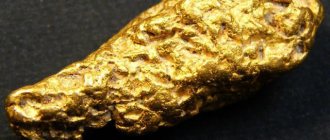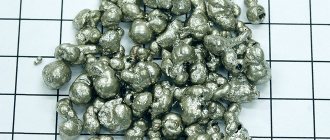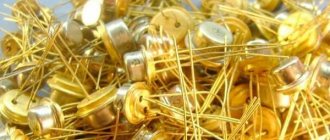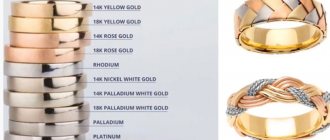Turning base metals like lead into gold is indeed possible, but you won't get much gold out of it!
Have you ever dreamed of becoming rich overnight? What if you could make gold from other metals such as lead?
This is exactly what the alchemists of the Middle Ages tried to achieve. Their goal was a "philosopher's stone", an "elixir" or a "tincture" that would grant immortality, youth and freedom from all diseases, as well as untold wealth to those who consumed it. One of the most interesting properties of the elixir was that it could turn any base metal, such as lead, into a sparkling piece of gold. The transformation of one element into another is called transmutation.
However, the elixir was legendary, and alchemists were never able to turn lead into gold. They failed because no ordinary chemical reaction can turn lead into gold.
However, could the scientists of the modern world, with our increased chemical knowledge and more advanced instruments, achieve this chemical feat?
Introductory information
Papyrus was found in the tomb of the Egyptian city of Thebes at the beginning of the last century. It contained 111 recipes, among which were those that considered the possibility of obtaining silver and gold. But, alas, this was aimed at creating fakes or coating other, less expensive objects with precious metals.
You may be interested in: Naphthenic acid - features, properties, application and formula
Nevertheless, this document showed that alchemy, even in ancient centuries, captured the minds of people thirsting for easy money. Spreading through the Egyptians and Greeks, it was able to gradually take over all of Europe. The greatest practical dawn came in the Middle Ages. At that time, not only scientists, but also state and church officials were interested in alchemy. Thus, in almost every imperial palace one could find “specialized” people who were supposed to receive gold in order to improve the state of the treasury. It was widely believed that this could be done with the help of the philosopher's stone.
Attempts to obtain gold from lead in ancient times
Oddly enough, the assertion that the history of mankind... teaches it nothing is clearly demonstrated by the example of a thousand-year-old riddle - how to get gold from lead. At the beginning of the last century, during the time of great archaeological discoveries in Egypt, a curious document was found among other things in one of the tombs near the city of Thebes. Papyrus dating from the Old Kingdom era described the most advanced metallurgy technologies at that time. And among the described recipes for producing alloys and pure metals, 111 recipes for producing precious metals were recorded. Such a list of possibilities for obtaining silver and gold simply amazed the imagination of how science was developed in those days.
True, it was necessary to give credit to the author of the manuscript; he honestly admitted that most of the methods had nothing to do with filling the treasury. All the methods described showed how to properly make fakes, or apply the thinnest coating to other absolutely base metals. However, the document clearly showed that already in those days such a problem as obtaining gold from lead was actively being developed by alchemists.
The knowledge that came down from the Egyptians to the Greeks, and later to the Romans, was actively developed in scientific treatises and descriptions of research. And already at these times, in addition to alchemists officially recognized by the authorities, church services and those who represented the openly criminal world were actively involved in research. Everyone had different motives, but the result was the same - to melt down the lead and get gold.
In the Middle Ages, many alchemists tried to obtain gold from lead.
There are few historical documents that have survived to the present day about practical experiments in obtaining precious metal at home. In the Middle Ages, if a person did experiments on his own, he could experience the fire of the Inquisition on himself, but official alchemists specially encrypted the results of research so that if such a method was discovered, they would remain its only bearer.
So it turns out that in the texts of alchemists, the philosopher’s stone and reactions often appear, during which a true dragon and even the elixir of life are obtained.
The most popular and almost openly sold by scammers of all sorts and stripes, the recipe of Lull, the then famous alchemist, was as follows: first you need to get the elixir, and after that the reaction itself will transform lead. Already at the beginning of the 18th century, when the recipe was deciphered and philosophical mercury became lead, the green lion became lead oxide, and the black dragon, a mixture of lead powder and coal became known and the chemical reaction - distillation of vinegar-lead salt. The result was a product capable of carrying out the reaction of the reduction of gold from its solution and salts.
Is it possible to believe this theory today, probably, if only because this method of obtaining gold is quite rational and can be used in practice. True, it hardly confirms the theory that gold can be obtained from lead. There is no direct transformation here, but there is a reaction with a gold-containing solution or salt.
Raymond Lull - an outstanding alchemist of the Middle Ages
What were they able to achieve in the Middle Ages?
You may be interested in: Ram's horns: meaning and symbolism
Iron, gold, lead and mercury were considered related metals - that one of them could be transformed into the other. For example, take Lull's recipe. He suggested turning his attention to lead and burning it until the oxide of this metal was obtained. Then it was necessary to heat the resulting substance with sour grape alcohol in a sand bath. The gum obtained from evaporation was distilled. What remained had to be ground on a stone and touched with a hot coal. Then it was necessary to distill the substance again and the result was acetic-lead salt.
What is the value of this connection? In fact, a common chemical reaction is described, namely the distillation of acetic-lead salt. This connection could truly work wonders. Namely, to recover gold from solutions of its salts.
Physicochemical characteristics of metals, gold and lead
| Characteristics | Gold | Lead |
| Density | 19320kg/m³ | 11340 kg/m³ |
| Mechanical and chemical properties | molten metal of a greenish tint, in solid form it has a bright yellow color; resistant to oxidation, inert; the material is soft, ductile, easy to process | when smelting the material is silvery; upon contact with oxygen, it instantly oxidizes, changing color to bluish-gray; the softness of the material makes it susceptible to compression and rupture; oxide adhesive protects the material from reacting with concentrated acids |
| Electrical, thermal conductivity | Conducts electricity well and is a good thermal conductor | Doesn't conduct electricity well |
| Effect on the body | Hypoallergenic, does not cause health problems, does not accumulate in the body | Considered toxic to the human body: inhalation of vapors, contact with material may cause poisoning |
Lead and gold
Further development
You may be interested in: The concept of acceleration. Acceleration formulas for uniformly accelerated linear motion and circular motion. Acceleration of gravity
Alchemy flourished until the mid-seventeenth century. It was not possible to obtain gold from lead, as well as from other materials. Although chemistry was studied quite well. High-ranking officials of that time supported such hobbies, which had a positive effect on the development of applied research. Moreover, many rulers, kings and emperors were themselves alchemists. And many of the transformations they carry out are not deception; the precious metal was simply contained in the original substance and was simply isolated.
But over time, the number of people who believed in alchemy began to decrease. This was greatly facilitated by the fact that the philosopher's stone was declared as a panacea for all diseases. When this did not materialize in practice, people began to doubt alchemy. Although we were not completely disappointed. Many experiments still made it possible to obtain gold. True, this was due to the fact that some natural ores contain this precious metal in a certain amount. Thanks to various chemical reactions it was possible to purify and distill it.
Materials[edit]
First we need to get some lead. For this we buy solder. Unfortunately, lead solder is now prohibited, but if you look...
You can most likely find lead solder on the black market or on the darknet. But first you should look at a flea market. You can also look here.
Ok, now it needs to be cleaned. To do this, we evaporate it by heating it to 666 °C in a distillation apparatus. We condense and wait for it to harden. Now we have pure lead.
The rest of the materials can be obtained as events unfold.
First "successes"
The alchemist Gobmerg was able to obtain gold by melting silver with antimony ore. There was not much precious metal at the output. But the alchemist believed that the secret of transforming metals had been revealed to him. True, with an accurate analysis, it simply turned out that a certain percentage of gold was there from the very beginning.
The pharmacist Kappel was able to achieve a similar result in 1783 - he obtained the precious metal from silver using arsenic. This may be solely due to the precipitation of lead iodide. And the gold, as you probably guessed, was already in the ore.
The Philosopher's Stone and other experiments of alchemists
At the beginning of the last century, papyrus was found in a tomb in the city of Thebes. It contained 111 recipes, including methods for obtaining gold and silver. However, most of these recipes still related to methods of creating fakes or coating other metal with them. Nevertheless, such a document shows how widespread alchemy was even then and captured the minds of those hungry for easy money.
Isaac Newton
Originating from the Greeks and Egyptians, it gradually conquered all of Europe. In the Middle Ages, not only some scientists, but also persons of the highest state and church ranks were engaged in alchemy. Almost every imperial court had its own alchemists, intending to obtain gold and thereby improve the state of the treasury. To get gold, in their opinion, perhaps you just need to somehow find or create the philosopher's stone. The records of alchemists of that time were vague and difficult to understand. Here, for example, is Lull's recipe for obtaining such a stone. It was proposed to take the philosophers' mercury and burn it until a green lion is obtained, and then a red one. It already needed to be heated in a sand bath along with sour grape alcohol. The gum obtained from evaporation had to be distilled using a distillation apparatus. After this, the true dragon will remain in the distillation apparatus itself, which can be ground on a stone and touched with hot coal. After which it is distilled again, the result is burning water and blood - this is the elixir. Later, this recipe was deciphered. It turned out that mercury is lead, the green lion is its oxide, the red one is lead, and the black dragon is lead powder with coal. The result was an ordinary chemical reaction - the distillation of acetic-lead salt. Thus, products were obtained that were capable of reducing gold from solutions of its salts. Alchemy flourished in the middle of the 17th century. Then it was difficult to say what substance the alchemists were dealing with, but high-ranking officials supported such hobbies, which stimulated development. Many kings and emperors themselves were alchemists and, by the way, many of the transformations they performed were not entirely a hoax. It’s just that, most likely, the original substance already contained gold in one form or another. Over time, the number of people who believed in alchemy became fewer and fewer. This was due to the fact that alchemists declared the philosopher's stone a cure for all diseases. And when this was not justified in practice, people began to doubt alchemy. However, some transformations of metals could not yet be explained. The experiments of many ultimately yielded gold. This was due to the fact that some of the natural ores contain some amount of gold initially. And through various chemical reactions it was possible to purify it. In 1709, the famous alchemist Gobmerg obtained gold by melting silver with antimony ore. There was very little gold in the output, but he was sure that he had found the secret of transforming metals. Over time, when they were able to accurately analyze the ore, it turned out that a certain percentage of gold was contained there from the very beginning.
With the help of science
After atoms and transformation reactions were discovered, nuclear physicists replaced alchemists. The foundation in this case was laid by Dempster Arthur Jeffrey. By studying mass spectrographic data of the precious metal, the scientist came to the conclusion that there is only one stable isotope - with a mass number of 197. Therefore, if you want to make gold from lead (or transform another similar material), then it is necessary to ensure that the necessary nuclear reaction occurs. It is necessary that it gives the output isotope 197.
In 1940, this issue began to be studied in more detail. Experiments were carried out on the bombardment of neighboring elements of the periodic table with fast neutrons. These are platinum and mercury. A year later it was reported that success was achieved using the second material. Gold was obtained. But its isotopes had mass numbers of 198, 199 and 200. Scientists obtained gold, but it existed for a very short period of time. Although from experiments it was concluded that the best starting material is mercury. It is also theoretically possible to obtain gold from lead, but it is much more difficult to implement.
What is an element?
Transforming lead into gold means transforming one element into another. Each element is defined by the number of protons (called atomic number ) and neutrons (protons + neutrons = mass number ) that make up its nucleus; the number of electrons is not that important to the identity of the element.
Lead has atomic number 82 (82 protons in the nucleus), and gold has atomic number 79.
To change one element into another, you need to change the number of protons in the nucleus.
Changing the number of neutrons (while keeping the number of protons constant) in the nucleus results in different flavors of the same element, called isotopes . Lead is made up of four naturally occurring isotopes and many others created in the laboratory.
Explanation of the element's composition. (Photo: Tom29739/Wikimedia Commons)
Mercury processing
The most suitable for manipulation are materials with mass numbers of 196 and 199. Thus, from 100 grams of mercury you can expect approximately 35 micrograms of gold. It is easy to guess that due to the high cost of nuclear transformations, the price turned out to be much higher than the market price. Therefore, this method has not gained popularity.
Obtaining a stable isotope (gold-197) is theoretically possible on an industrial scale from mercury-197. But such a chemical element does not exist in nature. Although you can also pay attention to thallium-201. The truth here is that the problem is of a different nature - this element does not have alpha decay. Therefore, it is more urgent to obtain the mercury-197 isotope.
It can be obtained from thallium-197 or lead-197. It would seem, at first glance, that the second option is much easier. But even in this way, it is more difficult to obtain gold from lead, because these materials do not exist in nature and must be synthesized through nuclear transformations. That is, it is possible to make precious metal, but it is very difficult and expensive. And so the considered option is the most realistic answer to how to make gold from lead.
Transmutation through radioactivity
Atoms with very large nuclei cannot cope with their size, making them unstable. They shed excess weight by releasing protons and neutrons (alpha radiation), electrons (beta radiation), and electromagnetic radiation (gamma radiation).
Most elements after bismuth on the periodic table are radioactive.
Radioactive decay is not the best way to obtain gold. First, radioactive elements take months, even years or millennia, to decay into more common elements. Radium-226 takes 1,600 years to decay by half. Secondly, radiation can cause diseases such as cancer and thyroid problems.
Third, uranium, thorium and radium turn into lead after decay. Lead is stable and does not decay further, which is sad considering gold only has 3 fewer protons than lead.
Cold fusion
Nowadays it is impossible to make gold from lead at home - this process is too knowledge-intensive and expensive. This is due to the fact that it is necessary to carry out hot nuclear fusion. That is, it is necessary to reach significant temperatures, which in itself is very costly from an energy point of view.
If we manage to launch cold nuclear fusion, we will be able to obtain the precious metal at relatively low cost. True, in this case the relevant question is how to stop it/keep it under control.
In addition, receiving gold in huge quantities, humanity may stop appreciating it. After all, this metal is valuable not only due to its qualities and characteristics, but also because it exists in limited quantities. And also with cold nuclear fusion, it is necessary to take into account that the transformation of elements of the periodic table can only be carried out in one direction - from right to left. In this case, lead is very well suited for turning it into gold. But this, alas, is still in theory.
Transforming one element into another
These subatomic particles are bound together by strong nuclear forces that keep the nucleus stable. Trying to overcome these forces requires an enormous amount of energy.
Removing a proton or neutron from a nucleus would be like trying to lift Thor's hammer, Mjolnir, unless you are pure at heart. Adding a subatomic particle would be like trying to force magnets of the same pole to touch.
Both adding and subtracting subatomic particles release enormous amounts of energy.
But what if you could change the composition of the core? Unfortunately, this gives the element an identity crisis, upsetting the balance of power within the element. The element begins to emit subatomic particles to reach a more stable state, similar to what happens during radioactive decay.
Iron
It is one of the oldest metals known to man. The first metal products, according to the results of archaeological research, appeared in the fourth millennium BC. Iron is much cheaper than the yellow precious metal. This is due to the high content of iron ore in the depths. And as they say in the economics textbook, the greater the demand, the lower the price of the product.
Unlike gold, iron has several oxidation states, and it interacts very actively with the environment. Russia occupies a leading position in the world in terms of iron ore reserves.
You should immediately answer the question of interest: what is heavier, a precious metal such as gold or ordinary iron. To answer this you will need to look at the density of metals. The density of the precious metal is already known, let’s find the value for iron. It is equal to 7.844 grams per cubic centimeter. It follows from this that this metal, with an equal volume, is not only lighter than gold, but also silver and lead.
Uses of gold
The demand for the yellow metal determines not only its use in the production of jewelry and the increase in the state’s gold and foreign exchange reserves. It is also very widely used in many other areas.
In industry, gold began to be actively used due to its chemical properties. It covers mirrors operating in the far infrared range. This is especially useful when conducting all kinds of nuclear research. Gold is also very often used for soldering components made of various materials.
Another area of application is dentistry. This is due not only to the impossibility of the yellow metal entering into a chemical bond with the human body, but also to its incredible corrosion resistance.
Pharmacology also cannot do without the use of this amazing yellow metal. Gold compounds are now actively used in various medical preparations that save from a wide variety of diseases.
These are not the only uses for gold. Due to rapid progress, there is an increasing need to use gold content in technological innovations. From this we can conclude that yellow metal is not only an attribute of luxury, but also a useful technical tool, the importance of which is increasing every year.











